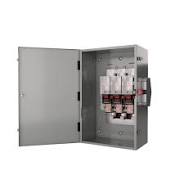MCB Vs MCCB: Key Differences And Best Uses
The protection of electrical circuits is crucial in every residential, commercial and industrial setup. Without a circuit breaker, you’ll always be at a high risk of house fires, short circuits and electricity overloads. Such events can quickly turn into your worst nightmare which is why investing in the right safety device is of utmost importance. Speaking of safety, two of the most commonly used devices in electrical circuits are MCB (Miniature Circuit Breaker) and MCCB (Molded Case Circuit Breaker). They both play a crucial role in safeguarding your electrical systems, but they are different in build, features and applications. If you are confused between MCB vs MCCB, then this guide is all you need to make a better decision.
Understanding A Miniature Circuit Breaker
MCB’s are also known as the first line of defence for any electrical failures, especially in households, offices and small commercial setups. These low-capacity breakers automatically and immediately shut down the circuit in case of an electricity overload or a short circuit. Depending on the model, these breakers usually have a breaking capacity of 10kA and current rating that goes up to 125amps.
Which is better MCB or MCCB in terms of ease of installation? Well, MCB does take the lead here especially due to its compact size. You can easily install it in any electrical panel!
Understanding A Molded Case Circuit Breaker
A molded case circuit breaker is best suitable for industrial grade applications that require more power. MCCB breaker for industry use are the best decision you’ll make, especially because they have the capacity to handle larger currents. Among MCB vs MCCB, the latter allows manual adjustment of the trip settings, making it a more flexible option. They come with a current rating of 2500amps and a breaking capacity that goes beyond 50kA. In a nutshell, if you want a circuit breaker that can easily handle heavy duty applications and is rugged then MCCB is the best suitable option for you.
Key Differences At A Glance
Here’s a MCB vs MCCB selection guide to make it easier for you to decide which one to buy!
| Features | MCB | MCCB |
|---|---|---|
| Size | Small and compact – Easy to install | Large and bulky – A little technical to install |
| Trip Adjustment | Comes with a fixed trip mechanism | You can manually adjust the trip settings |
| Cost | Low | Expensive |
| Breaking Capacity | 10kA | Up to 50kA |
When And Where Should Each Be Used?
Now that you are aware of MCB full form/MCCB full form along with their key differences and features, it’s time to learn about when and where you should use each.
MCB (Miniature Circuit Breaker): Best for small office setups, lighting systems and average residential circuits that don’t require much power to run. These breakers are easier to maintain, they are compact and very easy to install.
MCCB (Molded Case Circuit Breaker): Best suitable for demanding environments like factories with heavy machinery, industrial machinery and other heavy electrical loads. Even though these breakers are bulky and more on the pricier end, their adjustable trip settings and higher breaking capacity makes them a great choice for large electrical setups.
Things To Consider When Choosing Between MCB Vs MCCB
Best breaker for home use MCB or MCCB? Such questions are quite common especially if it’s your first time buying a breaker. For home use, MCB takes the lead. Other important factors you should consider are;
-
Load Capacity: For low current loads MCB is the best and for higher loads MCCB is good to go.
-
Breaking Capacity: Looking for higher breaking capacity? Go for MCCB and if you want lower breaking capacity for lighter applications then MCB is the winner.
-
Adjustability: MCB comes with a fixed trip setting whereas MCCB provides manual adjustment of the tripping mechanism, making it a more flexible option.
-
Cost And Maintenance: MCB’s don’t require much maintenance and they are more affordable as well. On the other hand, MCCB’s are more expensive but they do come with long term durability and flexibility.
Overall Verdict
Protecting your circuits from electrical damage is the main purpose of both MCB and MCCB breakers. However, they do operate on different scales so you have to consider your usage and requirements first. The best rule of thumb here is that for smaller and lighter applications (residential use) you should choose the miniature circuit breaker and and for power hungry and heavy applications (industrial and commercial use), you should opt for the molded case circuit breaker. The right choice just depends on your requirements,usage and application environment.
FAQs
A single-pole switch (SPST) controls one circuit with two positions: on and off. It's commonly used in household light switches.
A double-pole switch (DPST) controls two separate circuits with one switch action, acting like two SPST switches combined.
Choosing the right switch ensures durability and safety. Look for weather-resistant materials and proper voltage ratings to prevent failures.
Using an incorrectly rated switch can cause overheating, short circuits, and equipment damage, leading to safety hazards and increased costs.



